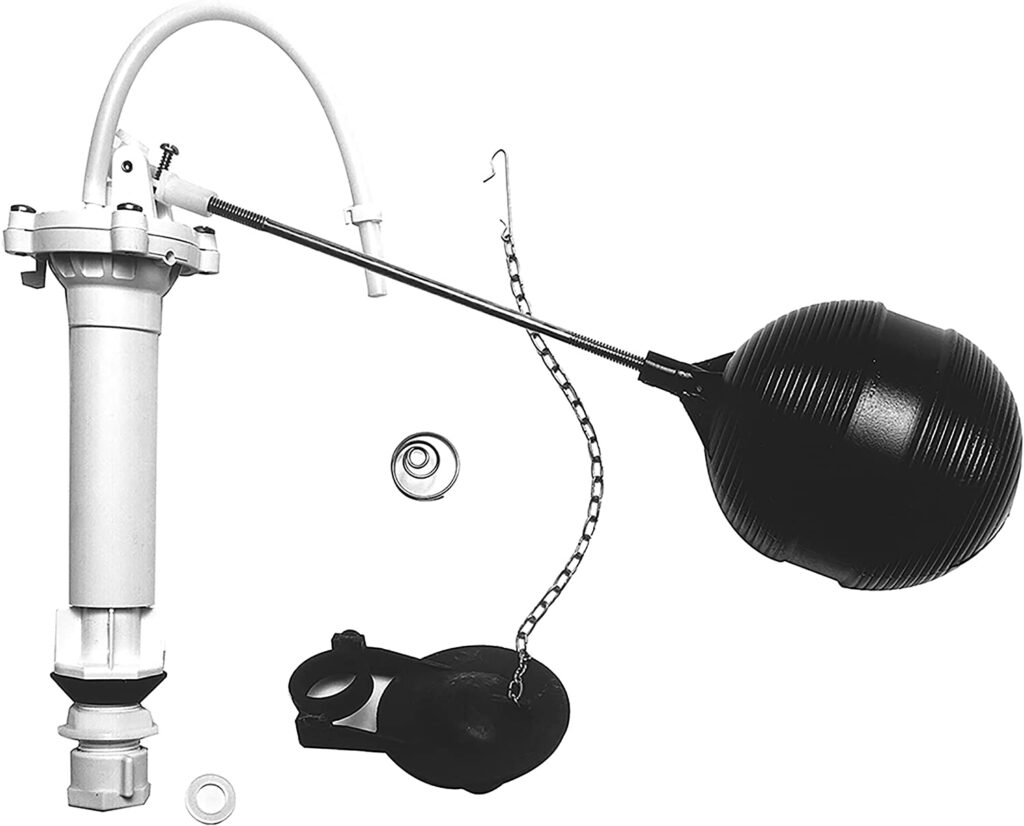
When things in your toilet aren’t working as they should, you might experience a degree of stress trying to figure out how to make them work. Several issues may prevent your toilet from functioning correctly, and a stuck float can be one of them. When a toilet float stops working as it should, large amounts of water could go to waste, and you might end up paying unnecessary water bills.
Where is the Toilet Float Located?
The toilet float is located inside your toilet tank. To see it, lift the tank lid. You’ve probably encountered a water float if you’ve had to deal with issues in your toilet. It’s a device that lets the water fill into the toilet tank and prevents it from overflowing. The toilet float is also called a ballcock or a float valve.
Old-style toilet floats had a plastic ball with a metal rod attached to them. If you live in a very old house, yours might be made of copper or brass. You may even come across vintage floats made of hand-blown glass. Nowadays, the flushing mechanism works with the help of a round cylinder or a float cup that uses a vertical arm to ride up and down.
How Does the Toilet Float Work?
The term ballcock comes from its original spherical appearance. It has a valve connected to a water supply. A lever attached to the float allows the intake to open and close, and the float rises as the water increases in the tank. Once the float gets to a pre-set level, a mechanism makes the lever slow the valve down, and the water supply switches off.
If the water in the toilet runs unexpectedly or turns off, there could be issues connected to the float. Bloat floats may develop cracks with frequent use and fill up with water. The ball float gets heavy when it fills up and will ride lower than it should. This can cause a toilet to run.
Do All Toilets Have a Toilet Float?
Whether you’ve never checked, or it’s been years since you lifted the lid of a toilet tank, you might not know what goes on in there. There are different toilet floats, and some don’t look like the traditional ones, which might confuse you. Modern toilets have other flushing systems with varying designs of toilet fill valves or smaller tanks.
How Can You Tell When a Toilet Float Valve is Stuck?
The toilet float fill valve is a mechanism that lets water get into the tank so subsequent flushes can be successful. When used regularly, fill valves can break down. Here’s how to tell that you’ve got a stuck float valve.
Your Toilet is Always Running
This is the most common sign that you’ve got a broken float valve. But, other reasons could make your toilet run. Always make sure you check inside the tank so you can ascertain where the issue is. The toilet float could have been set incorrectly if water is running over the fill valve and getting into the overflow hole.
To fix this, all you need to do is bend the floats arm downwards so the float can trip the water shut off when it’s at a lower level. If this process works, the valve is OK. The next thing you should do is check the chain that connects the flapper and a handle.
Sometimes, the chain may become twisted or bent and won’t come down far enough to let the flapper seal as it should. This means that the water runs out of the tank as soon as it gets in and eventually runs. If the flapper is the wrong size or doesn’t sit well on the drainage hole, the fill valve will continue to fill up the tank.
Ensure the drainage hold is sealed by holding the flapper down. Check if the water gets to the proper height. If the tank continues filling when the float gets to the shut-off point, it’s spoilt.
Flush is Weak, or the Toilet Won’t Flush.
When there’s no flush or the flush is weak when the toilet handle is depressed, this means that the tank isn’t getting enough water. A weak flush may be caused by a shut-off that’s too low. You can fix this by bending the float arm upwards to see if the fill valve causes the issue. When there’s no flush at all, the fill valve may be blocked or broken and isn’t sending water into the tank.
The Tank is Takes Too Long to Refill
If the toilet tank takes too long to fill once you’ve flushed, the water may have difficulties going through the fill valve. Check whether you can remove any blockages in the valve before you replace the entire thing.
How Do You Adjust a Toilet Float Valve?
Toilet parts such as the float valves come in two different types.
- An arm and a float that’s connected to it
- A floating cylinder moving up and down
Adjusting the float valve is a common repair in the household because these parts are responsible for the water that gets into your tank and how much is released each time you flush. They get used pretty often, so you might have to make minor adjustments once in a while. Here’s how you can do this:
Remove the tank lid: some float valves have a lever with the float attached to the valve top. As you flush, the float pushes its arm downwards and alerts the fill valve to allow water to come up till it’s at the right level. To fix this kind of toilet valve, lift the lid and put it in a safe area. Then, find the fill valve on the left of your tank.
Find the adjustment screw: you need a flat-head screwdriver to adjust the toilet float. Place it into the adjustment screw on the fill valve.
Adjust the adjustment screw: moving in a clockwise direction, turn the screw and raise the float from the end of the arm. This will increase the amount of water needed to shut the valve off. You can also turn the screw anticlockwise to lower its arm and reduce the amount of water required to shut the valve.
Refill: flush the toilet and allow it to refill. This helps to test the water level. Put the tank lid back and repeat the steps you’ve done above until you achieve the right level of water.
How to Adjust Cylinder Float Valves
This is the other type of toilet fill valve. You will find such parts in modern toilets. Here’s how to adjust them:
Removing the toilet tank lid: put the toilet lid on a safe surface. Identify the fill valve on the left of your tank.
Pinch and slide the valve cylinder: locate the float clip on the side of the cylinder and pinch it. Slide it upwards to increase the water needed to shut off the float fill valve. You can also slide it downwards to reduce the amount of water. Use pliers if you want an easier way to squeeze the clip.
Refill: flush your toilet and allow it to refill so you can test the level of water. Put back the lid. If you haven’t achieved the correct water level, repeat the above steps.
Let White’s Plumbing Handle It
If you are still having issues troubleshooting your plumbing, it may be time to let the pros help. White’s Plumbing can fix any plumbing issues that you may have with your toilet or other appliances. Don’t hesitate to contact White’s Plumbing today to have your plumbing issues fixed.




